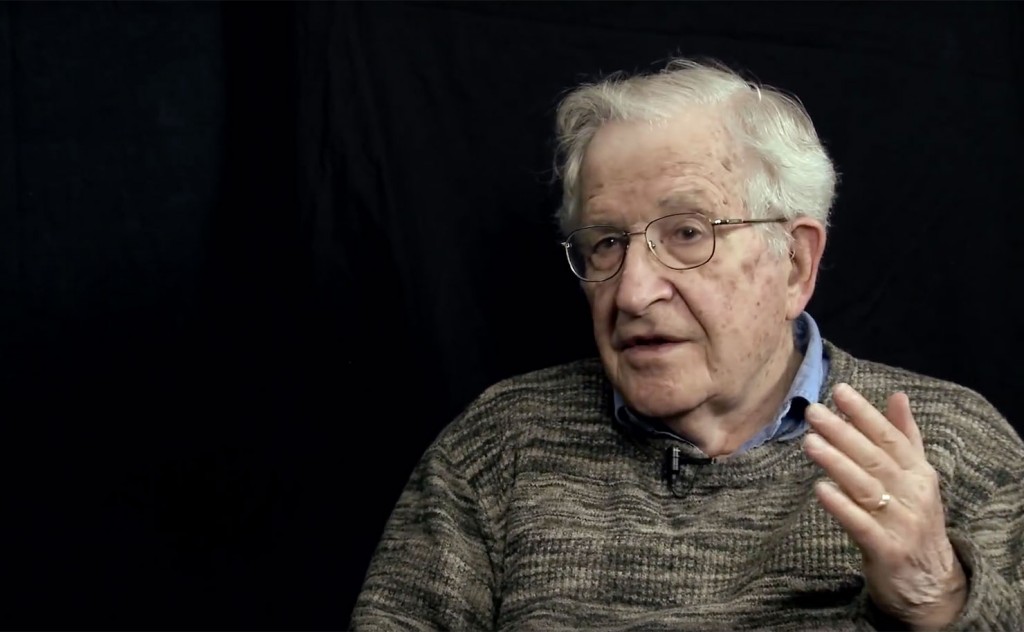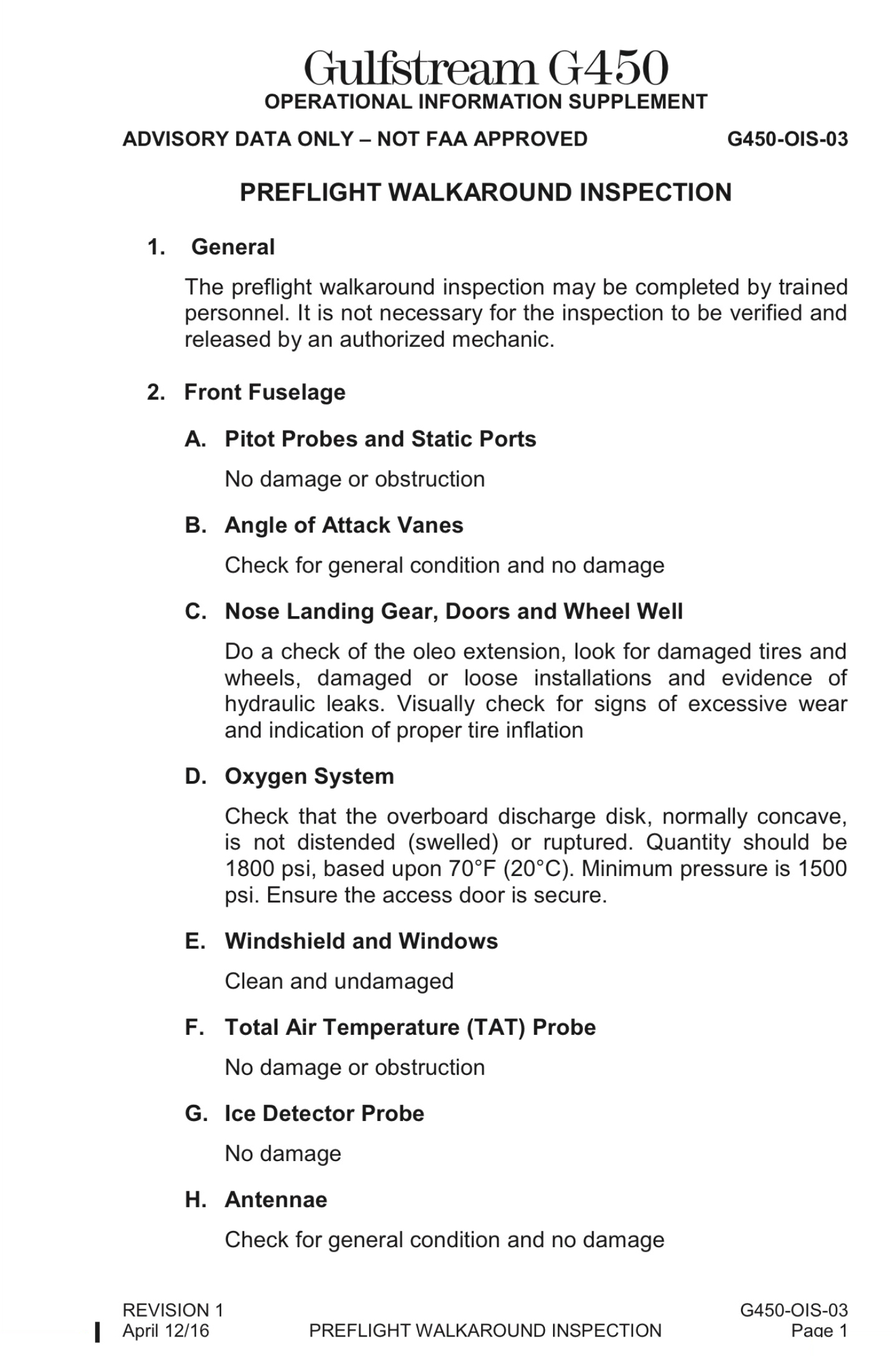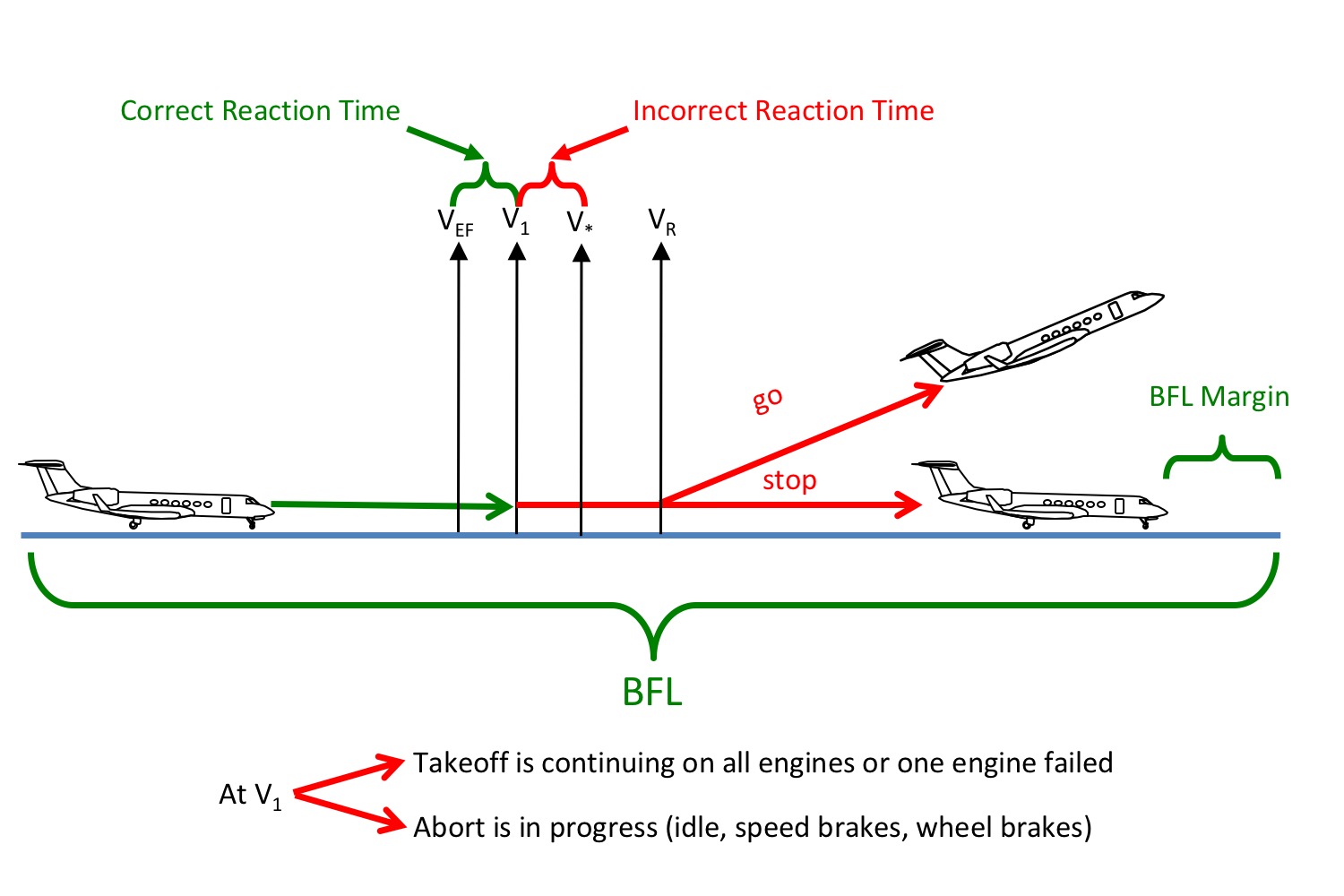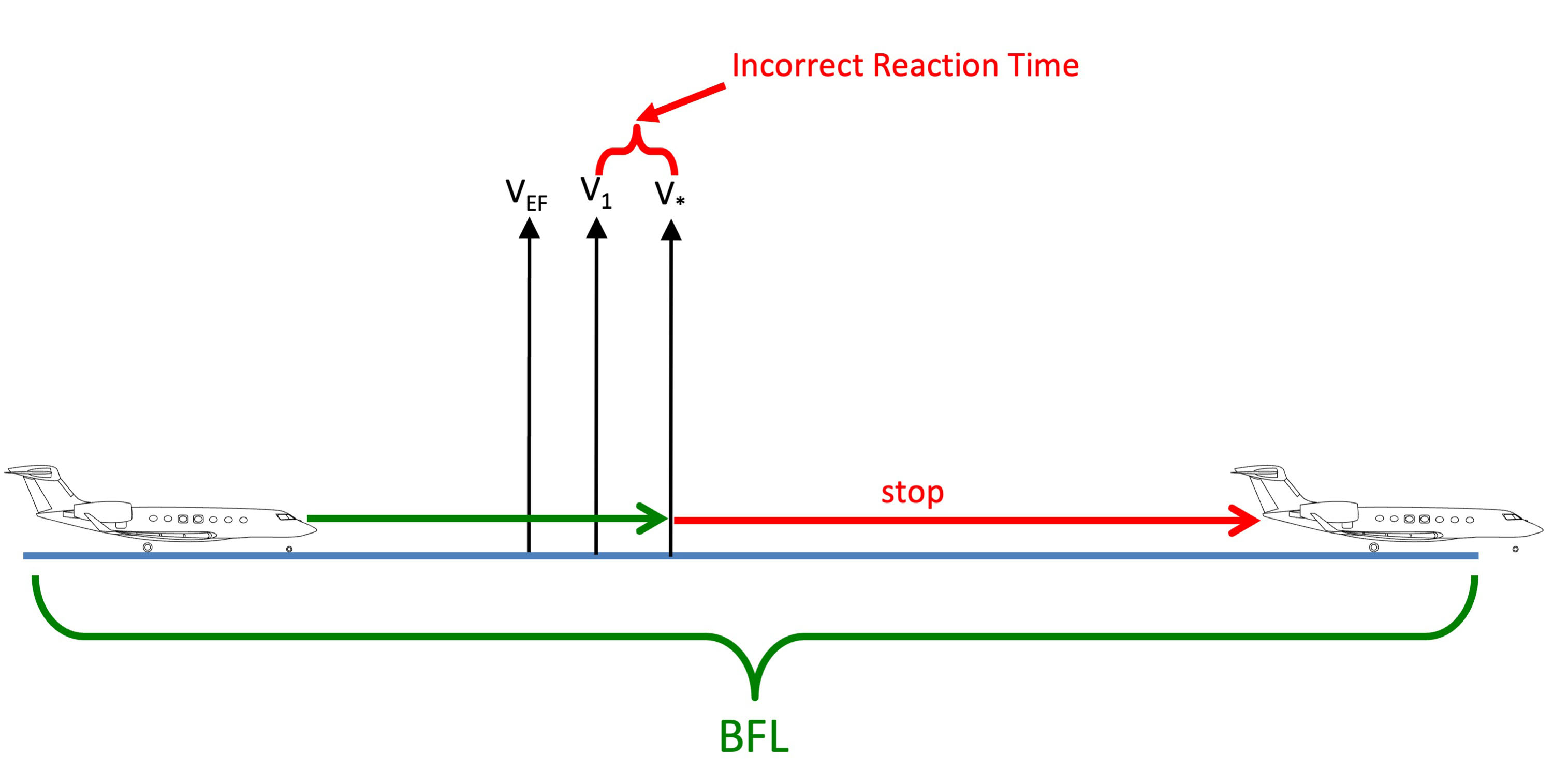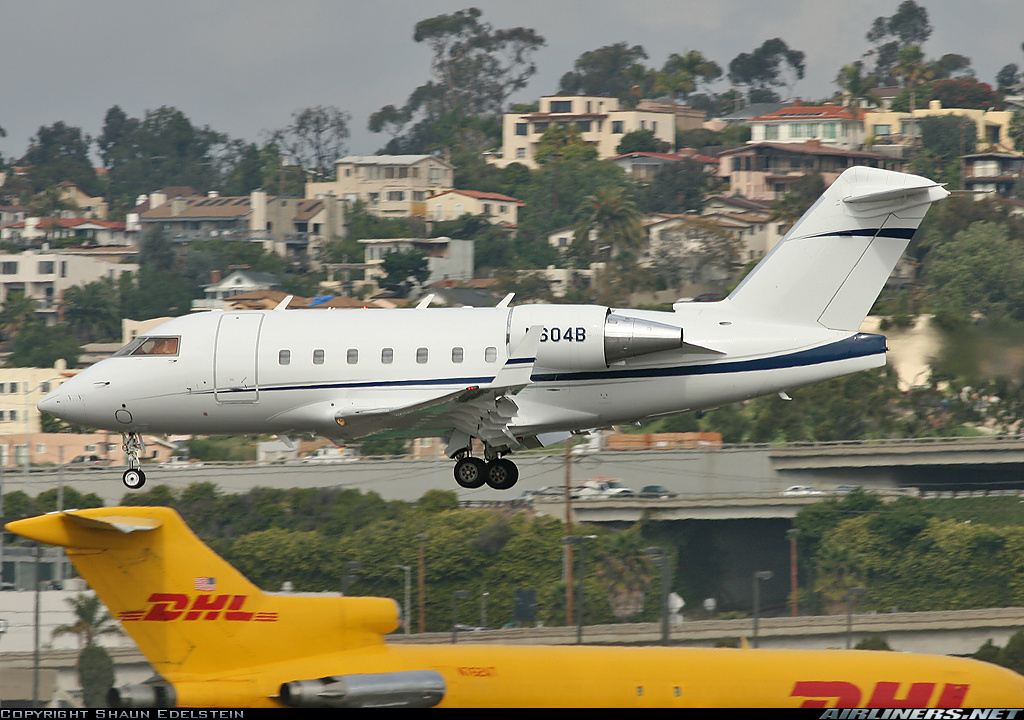Sophistry? What is it? Why does it matter to a pilot?
— James Albright

Updated:
2018-08-16
First: What is it?
sophistry
[ˈsäfəstrē]
NOUN
the use of fallacious arguments, especially with the intention of deceiving.
Here's a demonstration: Pure Whadoyacallit.
Just about everything that follows are just my opinions. I am going to lump all the school houses into one and call it "Brand X Sims". Over the years I've written several very long critiques that got Brand X Sims instructors disqualified, counseled, and fired. You might think I am being a troublemaker, especially since I've robbed several of these instructors of their livelihood. Perhaps. But I hope I've saved a few pilots from a fate that is far worse.
Of course I am not alone in this battle. I hear lots of war stories, here are a few Letters from our readers.
Why does it matter to a pilot? It matters because it is a leading technique of instructors who are inept or are in positions where they need to feel intellectually superior to students. We see a lot of this in business aviation because those out in the field often have more experience than those in the school houses, make more money, and quite often know their airplanes better than those teaching it. I've witnessed several instances where the instructor in question was teaching things that could get people killed. Half the students realized it was all wrong and ignored it. The other half dutifully took notes. Those of us who know better owe it to those that don't to raise the "BS Flag" and call them out.
I think the best way to learn to spot sophistry in action is to look at one of the greatest "sophists" in history. Then we can look at a few examples of how Brand X Sims has tried to sucker its students into flying dangerously.

1
Noam Chomsky: King of sophistry
A falsehood, told with conviction by an authority figure, can be accepted at face value by those who should know better. This can be a problem that translates into safety issues rather quickly in aviation. But we professional aviators tend to think of ourselves as experts with skeptical eyes. We know the stakes are high so we have very low thresholds on our "BS Detectors." Consider, then, the case of Noam Chomsky. He is a rock star in the world of linguists, to this very day. But his arc to rock star status is a classic case of sophistry; his story can be instructive to anyone who needs to detect BS.
On or about the year 1858
Our story begins inside the aching, splitting head of Alfred Wallace, a thirty-five-year-old, tall, lanky, long-bearded, barely grade-school-educated, self-taught British naturalist who was off — alone — studying the flora and the fauna of a volcanic island off the Malay Archipelago near the equator . . . when he came down with the dreaded Genghis ague (rhymes with "bay view"), today known as malaria.
Source: Wolfe, p. 6
For at least sixty-four years British and French naturalists [ . . . ] had been convinced that all the various species of plants and animals of today had somehow evolved from earlier ones.
Wallace had the Eureka! moment to posit that animal populations go through the cycle of birth and death from generation to generation so that only the "fittest" — a term he coined — survive. After many generations, he believed, new species would be created. But there was no proof. Regardless, he drafted a manuscript and sent it, in March of 1858, to a British gentleman of means, a Mister Charles Darwin.
Charles Darwin, Esq., was the product of two-hundred years of upper class privilege. His father and his father's father were both doctors who amassed huge fortunes. Charles was sent to the University of Edinburgh to study medicine, but he dropped out. He then went to Christ's College at Cambridge to become a clergyman. But once again, he dropped out. He settled for a bachelor of arts degree and was sent on a five-year vacation around the world aboard the HMS Beagle. He returned to England in 1836 to write a highly praised book, Journal of Researches, that provided a journal of all that he saw during his five year voyage. This gained him his entry into the world of British gentlemen, where he could contemplate an idea that had been percolating in his head, something he called "transmutation." He must have been quite alarmed when Wallace's manuscript arrived. They were both naturalists, but Wallace was a common plebe out there in the world doing the work in the trenches. Darwin was a British gentleman. In the end Darwin forwarded Wallace's work alongside notes he hastily put together. As these things often happen, the Theory of Evolution carried Darwin's name and not Wallace's. For the rest of his life, Darwin was worried that he would be discovered as a fraud, someone who had stolen the work for which he had become famous.
Source:Wolfe, p. 8
As a dedicated naturalist he had an even bigger problem: a huge gap in evidence when it came to language, which set humans far apart from any animal ancestors. It gnawed at him. He could explain man's opposable thumb, upright stature, and huge cranium, but he couldn't find one shred of solid evidence that human speech had evolved from animals. Speech seemed to have just popped up into the mouths of human beings from out of nowhere. He thought and thought. And thought ... Wait a minute. What was speech? Vocal communication, right? Well, animals had their forms of vocal communication, too, and some were fairly complex. Vervet monkeys had different cries to warn the troop of the presence of the most dangerous predators. They had one cry for leopards, another for eagles, another for baboons, another for pythons, plus variations of the python cry to indicate a mamba or a cobra. They used certain intonations to indicate that a particular fellow vervet's reports weren't altogether reliable. There you had it: monkey semantics. If that wasn't the equivalent of speech, what was? All right, there was no direct evidence to point to ... but it was self-evident, wasn't it? Animal speech like the vervet's had evolved into human speech ... somehow ... and if there was no clear evidence ... well, it just meant nobody had looked hard enough, because it had to be there somewhere. Wallace, for his part, gave up on thinking of this theory as explaining the evolution of everything. But the world was ready for a theory of everything. Even lacking any empirical evidence, the world accepted evolution as scientific fact.
So, for the next one-hundred years, linguists searched in vain for some kind of evidence to back up the theory that put them on the scientific map. Darwinism itself is an exercise in sophistry. In all this time, not a single case of species evolution has been documented. Of course these things take time, you could argue. So let's narrow our focus to the search for proof of an evolutionary basis for the development of human speech. And that's where Noam Chomsky enters the picture.
Source: Wolfe, pp. 19-20
On or about the year 1957
I used to say, tongue in cheek, that you can make anyone believe anything if you say it with enough conviction. And that's where we meet Noam Chomsky, who in 1957 was a graduate student at the University of Pennsylvania studying a social science, linguistics, that had been to that point considered a "lesser science."
State the idea.
This moment, the mid-1950s, was the high tide of the "scientificalization" that had become fashionable just after World War II. Get hard! Whatever you do, make it sound scientific. Get out from under the stigma of studying a "social science"! By now "social" meant soft in the brainpan. Sociologists, for example, were to observe and record hour-by-hour conversations, meetings, correspondence, objective manifestations of status concerns, and make the information really hard by converting it into algorithms full of calculus symbols that gave it the look of mathematical certainty-and they failed totally. Only Chomsky, in linguistics, managed to pull it off and turn all-or almost all the pillow heads in the field rock-hard. Even before receiving his PhD, he was invited to lecture at the University of Chicago and Yale, where he introduced a radically new theory of language. Language was not something you learned. You were born with a built-in "language organ." It is functioning the moment you come into the world, just the way your heart and your kidneys are already pumping and filtering and excreting away.
I think proof of the allegation that linguistics is a soft science can be seen by how willingly its proponents accepted Chomsky's discovery of a "language organ" with no proof. They accepted it as fact, saying it was only a matter of time before it was discovered. The search continued for 50 years before they gave up.
Source: Wolfe, p. 87
Elaborate with examples.
To Chomsky, it didn't matter what a child's first language was. Whatever it was, every child's language organ could use the "deep structure," "universal grammar," and "language acquisition device" he was born with to express what he had to say, no matter whether it came out of his mouth in English or Urdu or Nagamese. That was why-as Chomsky said repeatedly-children started speaking so early in life ... and so correctly in terms of grammar. They were born with the language organ in place and the power ON. By the age of two, usually, they could speak in whole sentences and generate completely original ones. The "organ" ... the "deep structure" ... the "universal grammar" ... the "device" -as Chomsky explained it, the system was physical, empirical, organic, biological. The power of the language organ sent the universal grammar coursing through the deep structure's lingual ducts to provide nutrition for the LAD, which everybody in the field now knew referred to the "language acquisition device" Chomsky had discovered.
The absurdity here, of course, is that there was no such discovery, no proof. It was simply a theory. How is it that an established field gave way so quickly to someone new?
Source: Wolfe, p. 88
Explain with unproven or unrelated "facts."
That was where Chomsky's soon-to-be-famous Martian linguist came in. A Martian linguist arriving on Earth, he often said ... often ... often ... would immediately realize that all the languages on this planet were the same, with just some minor local accents. And the Martian arrived on Earth during almost every Chomsky talk on language.
This is a key technique of sophistry. You explain something as if it is a widely accepted fact, as if no explanation is needed. But there is more . . .
Source: Wolfe, p. 89
Dismiss those who object as uninformed, uneducated, or unwise.
Only wearily could Chomsky endure traditional linguists who [ . . . ] thought fieldwork was essential and wound up in primitive places, emerging from the tall grass zipping their pants up. They were like the ordinary fly catchers in Darwin's day coming back from the middle of nowhere with their sacks full of little facts and buzzing about with their beloved multi-language fluency. [ . . . ] But what difference did it make, knowing all those native tongues? Chomsky made it clear he was elevating linguistics to the altitude of Plato's-and the Martian's transcendent eternal universals. They, not sacks of scattered facts, were the ultimate reality, the only true objects of knowledge. Besides, he didn't enjoy the outdoors, where "the field" was, and he knew only one language, English. You couldn't very well count the Yiddish and Hebrew he spoke at home growing up. He was relocating the field to Olympus. Not only that, he was giving linguists permission to stay air-conditioned. They wouldn't have to leave the building at all, ever again ... no more trekking off to interview boneheads in stench-humid huts. And here on Olympus, you had plumbing.
After decades of searching, it became obvious to everyone, even Chomsky, that there was no evolutionary link in the development of language in humans. A new generation of linguists started openly mocking Chomsky, who no longer had the unsailable charm of year's past. In 2014, finally, Chomsky teamed up with three colleagues at MIT to publish an article titled "How could Language Have Evolved?" The 5,000 words were summed up neatly:
Source: Wolfe, p. 89
"The evolution of the faculty of language largely remains an enigma."
Source: Wolfe, p. 150
Writer Tom Wolfe sums Chomsky's efforts up thusly:
An enigma! A century and a half's worth of certified wise men, if we make Darwin the starting point-or of bearers of doctoral degrees, in any case-six generations of them had devoted their careers to explaining exactly what language is. After all that time and cerebration they had arrived at a conclusion: language is ... an enigma? Chomsky all by himself had spent sixty years on the subject. He had convinced not only academia but also an awed public that he had the answer. And now he was a signatory of a declaration that language remains ... an enigma?
Source: Wolfe, p. 150
"Little enough is known about cognitive systems and their neurological basis," Chomsky had said to John Gliedman back in 1983. "But it does seem that the representation and use of language involve specific neural structures, though their nature is not well understood."
Source: Wolfe, p. 150
It was just a matter of time, he intimated then, until empirical research would substantiate his analogies. That was thirty years ago. So in thirty years, Chomsky had advanced from "specific neural structures, though their nature is not well understood" to "some rather obscure system of thought that we know is there but we don't know much about it."
Source: Wolfe, pp. 150-151
In three decades nobody had turned up any hard evidence to support Chomsky's conviction that every person is born with an innate, gene-driven power of speech with the motor running. But so what? Chomsky had made the most ambitious attempt since Aristotle's in 350 BCE to explain what exactly language is. And no one else in human history had come even close. It was dazzling in its own flailing way-this age-old, unending, utter, ultimate, universal display of ignorance concerning man's most important single gift.
Source: Wolfe, p. 150
The lesson in all this
There is, of course, a macro lesson for life in general here, as well as a micro lesson for us aviators. First, the macro. Charles Darwin advanced his stolen idea of evolution with no evidence of even a single evolved species. (That was over 150 years ago and there is still not a single example.) He also had two glaring inconsistencies. First, his theory prohibits what is known as "injurious evolution." Natural selection cannot make a new species worse than the one before. Apes are pretty much water proof because of their hairy skin and stronger than the humans who supposedly followed. This violates the prime directive of the theory of evolution. Second, no previous species have the gift of speech. But his theory is now considered absolute fact. Noam Chomsky's attempt to establish the evolution of language is widely discredited within the community of scientists. He has written voluminously, is often cited, but has more discredited theories to his name than ideas that have survived the test of time. And yet he remains a respected figure in academia.
But you didn't come here for a science lecture. What does all this mean for us aviators? In short, some instructors can become sophists without knowing it. They learn just enough to convince others they are experts. Then, with a clever turn of phrase, they can instruct others to believe as they do.
Those of us who fly for a living need to learn how to detect sophistry before it can corrupt our own thought processes. I know someone who attended several of Chomsky's lectures in the sixties and saw right through his sophistry while others ate it all up. She was able to detect it. You can too.
2
Three examples
One of the most difficult aspects of sophistry is detection. The practitioners tend to either have the gift of conversation or are in positions where audiences are required to listen. I saw a lot of that in the military where the senior officer has a flock of subordinates who have no choice but to listen, even if the senior officer knows less than they do. But it can be even worse in the real world of flying airplanes. When you show up at "Brand X Sims" the instructors are supposed to be the experts. I hope three examples from my history can help you detect these charlatans before they do any more damage. It will be tempting to just dismiss their efforts as harmless. But I encourage you to challenge them, in case other pilots don't have the wherewithal to detect them as you have.
The optional preflight — Why make it hard when it can be easy!
I was getting a little bored with going to the same "Brand X Sims" training center every six months so I decided to give another location a try. I had never been to the new location but I signed up and was told my ground school instructor was the best they had. Let's call him Skip. I asked around to find out about Skip and was told he knew his stuff. "You will like him," one colleague said. "He talks way above my head." Another friend said he found Skip intimidating.
I walked into the class and met the man, who seemed nice enough. I looked on the main screen projector and was presented with a checklist I had never seen before.
Skip's very first words were a shocker: "Nobody does the complete exterior preflight inspection listed in the AFM, nobody!"
I sat in my seat, wondering what kind of joke this must have been. Skip pranced in front of the class and said the AFM exterior preflight inspection was meant for mechanics and that no real pilots actually did it.
Sophistry Technique: State claims in terms of "Everybody" or "Nobody" to put non-believers on the defensive.
Skip offered a brand new Operational Information Supplement as proof. "Gulfstream agrees with me!" he said. "That's why they just put out this OIS. All you have to do is what's listed right here. Nobody does everything on the AFM exterior inspection! We are too busy checking the weather, conducting crew briefings, dealing with catering."
My eyes raced over the page while digging through my computer for the new OIS. What about the brake and landing gear emergency extension accumulators? I found the OIS and found item after item that were missing from the new OIS. Skip was spending a lot of time on this obscure OIS and seemed to delight repeating his shocker. "Nobody does the exterior inspection!"
"I do," I said.
"Then you are wasting your time," he said. "I have to wonder what you aren't doing while you are wasting your time spending an hour doing the exterior inspection checklist."
Sophistry Technique: When confronted by a non-believer, belittle them.
I held my fire until the break and called a contact at Gulfstream. They were just as confused as I was. (I found out weeks later the OIS was intended for crew chiefs at a foreign country at special request, not for pilots. My Gulfstream contact emphasized that the exterior inspection checklist, as part of the AFM, was FAA approved and wasn't optional.) I realized confronting Skip during a break would be fruitless and perhaps a meeting with the "Brand X Sims" center manager was in order.
V1 — Lots of time!
After the first break, Skip said that when V1 is called during takeoff, “you have two seconds” to react. A member of the class protested, saying that he had always been taught that V1 is an “action” speed and not a “decision” speed. Skip said that was true for older aircraft, but not newer “Amendment 97” aircraft.
Sophistry Technique: Cite an obscure reference to shut down debate.
I pulled out my computer and did a search of the hard drive looking for "Amendment 97" and came up empty. I then heard my name and looked up to see the class looking at me. "Everyone wants to know what you think about this, James."
"It think this is BS," I said. "What is amendment 97?"
He said, “You know, aircraft certification rules.” I asked, “are you referring to Part 25?” He said yes. As the debate continued I looked up the applicable sections in Part 25 and didn’t find any such amendment. “Oh, maybe it is was Amendment 94.” I found the specific section of Part 25 that covers V1, 14 CFR 25.107, and noted that the regulation specifically says the reaction occurs between the time of the engine failure and V1, and that the “first action” occurs at V1.

14 CFR 25, §25.107
I read the selection but Skip waived me off. He said that the "Brand X Sims" position was that new aircraft, like the G450, have two seconds after V1 and that we were all wrong about this. He promised to get the "Brand X Sims" Reference for us. Following the break he showed a slide at referenced 14 CFR 25.109 that contained an extract. I didn’t recall the extract exactly, other than it did not include the title of the paragraph and just an extract: “A distance equivalent to 2 seconds at the V1 for takeoff from a dry runway.”
Sophistry Technique: Cite the organization as the source.
I pulled up the regulation itself and saw immediately that this was an “apples and oranges” argument. 14 CFR 25.109 describes accelerate-stop distance.
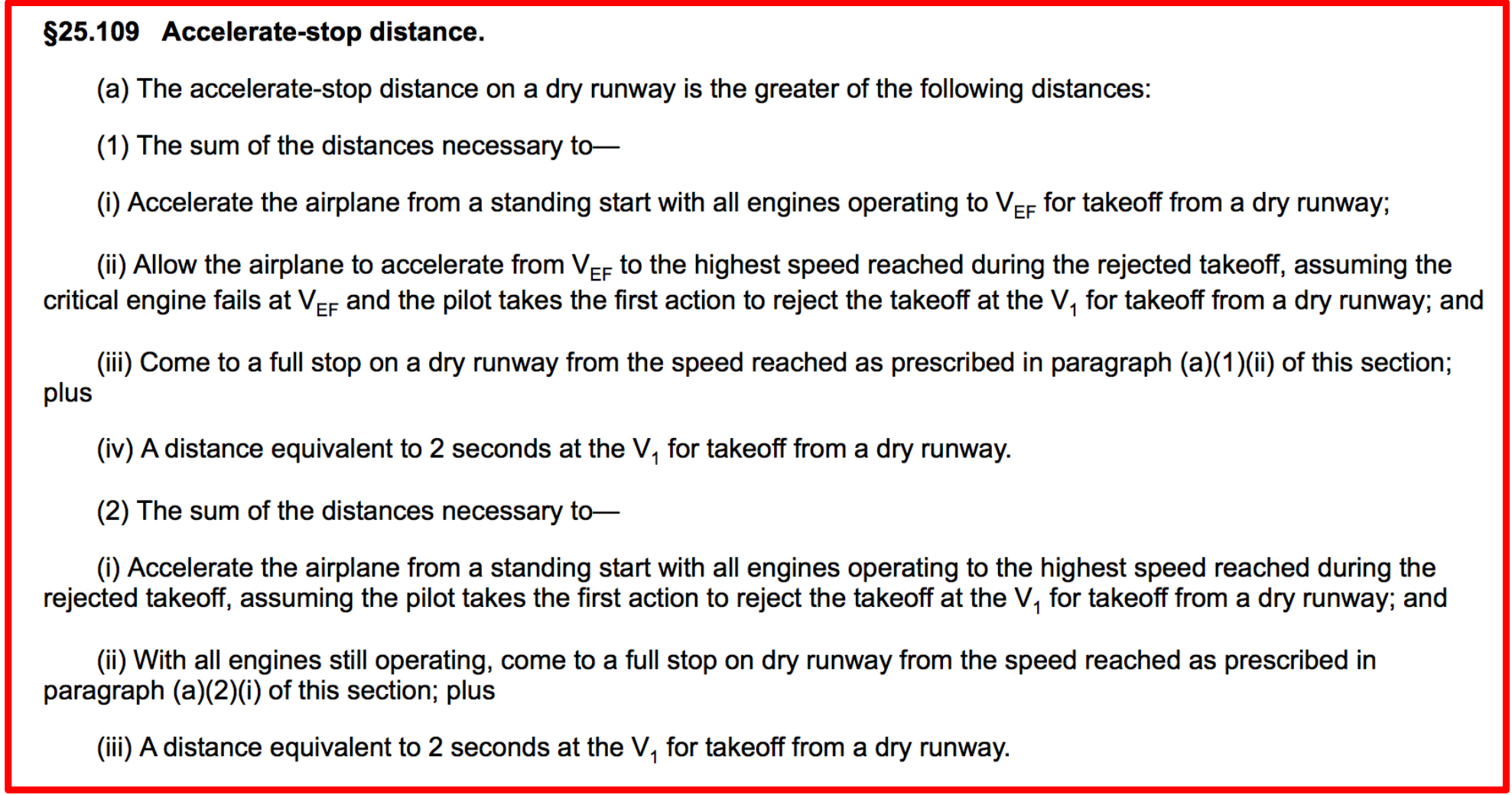
14 CFR 25, §25.109
I described how the 2 seconds at V1 speed was used for determining the distance of the BFL margin, nothing more. Furthermore, I said, delaying the abort for those 2 seconds would increase the distance required to abort beyond the safety margin. Skip returned to his "Brand X Sims" slide that showed V1 gives us a 2 second pad. "You might be pretty smart," he said, "but we have some pretty smart people at Brand X too. Are you saying you know better than us?"
Sophistry Technique: Accuse non-believers of narcissism.
"That's exactly what I am saying," I said. I approached the chalk board and started to draw.
"And what happens if we wait two seconds?" a fellow student asked.
At this point the rest of the class pounced on Skip’s logic. After two hours of this he finally declared that he had been saying the two seconds occurs before V1 and not after. Leaving aside the fact the G450 decision time is half that, the class allowed the subject to drop.
Sophistry Technique: When caught in a lie, adopt the nonbelievers ideas as your own.
Skip continued as before, smiling. On the second day of the class, he reverted to his earlier "2 seconds after" claim. That evening I had a meeting with the assistant center manager. (The manager was away.) The next week I wrote a 30-page critique. (Skip had more than just the walk around and V1 issues.) Say what you will about "Brand X Sims," they reacted quickly. Skip was decertified and required to go through "Brand X Sims" instructor school again.
The Challenger's alternate landing gear extension system — Use only in an emergency!
About fifteen years ago I was flying this airplane:
I was in the left seat after taking off from Florida, heading back to Massachusetts. My boss, the chief pilot — let's call him Bob, was in the right seat. He is about ten years older than me and had double my total time. But I had twice his hours in jets and four times his hours in the Challenger. It was my third year flying the Challenger 604, not one of my favorites. The problem with the Challenger, as most Canadair pilots know, is the only system redundancy provided was the minimum required by law. If something broke, you tended to stay broke until the spare parts brigade arrived.
We were returning from Florida with the CEO and Mrs. CEO in back. I was flying the aircraft and Bob was riding shotgun. Passing 30,000 feet we got what Canadair, the aircraft designer, calls the triple chime and the number three display unit lit up with a stack of messages on top of which was the amber “HYD 3 LO PRESS” message we knew was the one hydraulic system we didn’t want to lose. Bob looked at me for some kind of reaction. He was the boss, but losing stuff in an airplane was where I grew up.
“Pull up the synoptic.”
He did so and the video game told us what we both knew, the number three system had lost all of its hydraulic fluid, we lost half our wheel brakes, normal landing gear operation, and a third of our flight control power. Bob stared for a few moments more. “Turn the number three pumps off,” I said, “tell center we are declaring an emergency and need immediate clearance to . . .” I scanned the map display “. . . Charleston. We’ll need a long final so we can use the manual gear extension system.”
As long as I gave Bob a specific task he seemed to be happy, but as soon as he became idle he fell to staring at the synoptic page, zombie-like. Center obliged us with a long final and we had everything set up for the manual gear extension with nothing to do but wait. Bob toggled the PA and called the CEO to the cockpit.
The CEO appeared moments later and Bob pivoted in the right seat to give him the bad news. “Sir, we’ve lost a hydraulic system and have to do an emergency landing.” I diverted my forward gaze a bit to see the CEO’s reaction. There was none. “We are headed to Charleston where, if we can do an emergency extension of the landing gear, we will land. Please make sure you and Mrs. Bowman are strapped in tight, it could be a bumpy landing.”
Now there was a reaction, a pale, speechless reaction that spoke volumes. The CEO turned back to the cabin and I just couldn’t keep silent. “Mister Bowman,” I called, “just a minute, sir.” I pointed at the synoptic on our fourth display unit. “We have three hydraulic systems on this aircraft but we can fly with only one. The reason we are landing short of our destination is because we don’t like operating without a backup. There is no reason to be concerned, I’ve landed this airplane more than a few times with a hydraulic system failed. I don’t expect any problems on landing, but seat belts are definitely in order.”
“Oh,” he said with a sigh, “okay. Thanks.” Of course all that was true, but I had never lost the number three system in the Challenger and have never had to do a manual extension of the landing gear on any aircraft except to test the system. We set up for a twenty-mile final to give us time to extend the landing gear. The emergency extension handle sits between both pilots and requires considerable force to pull. I’ve seen a few gorillas in the simulator do it while seated, but not me. “You might want to get out of your seat,” I said, “let’s extend the gear.” Bob knelt over the handle. “Ready,” he said. “Pull the handle.”
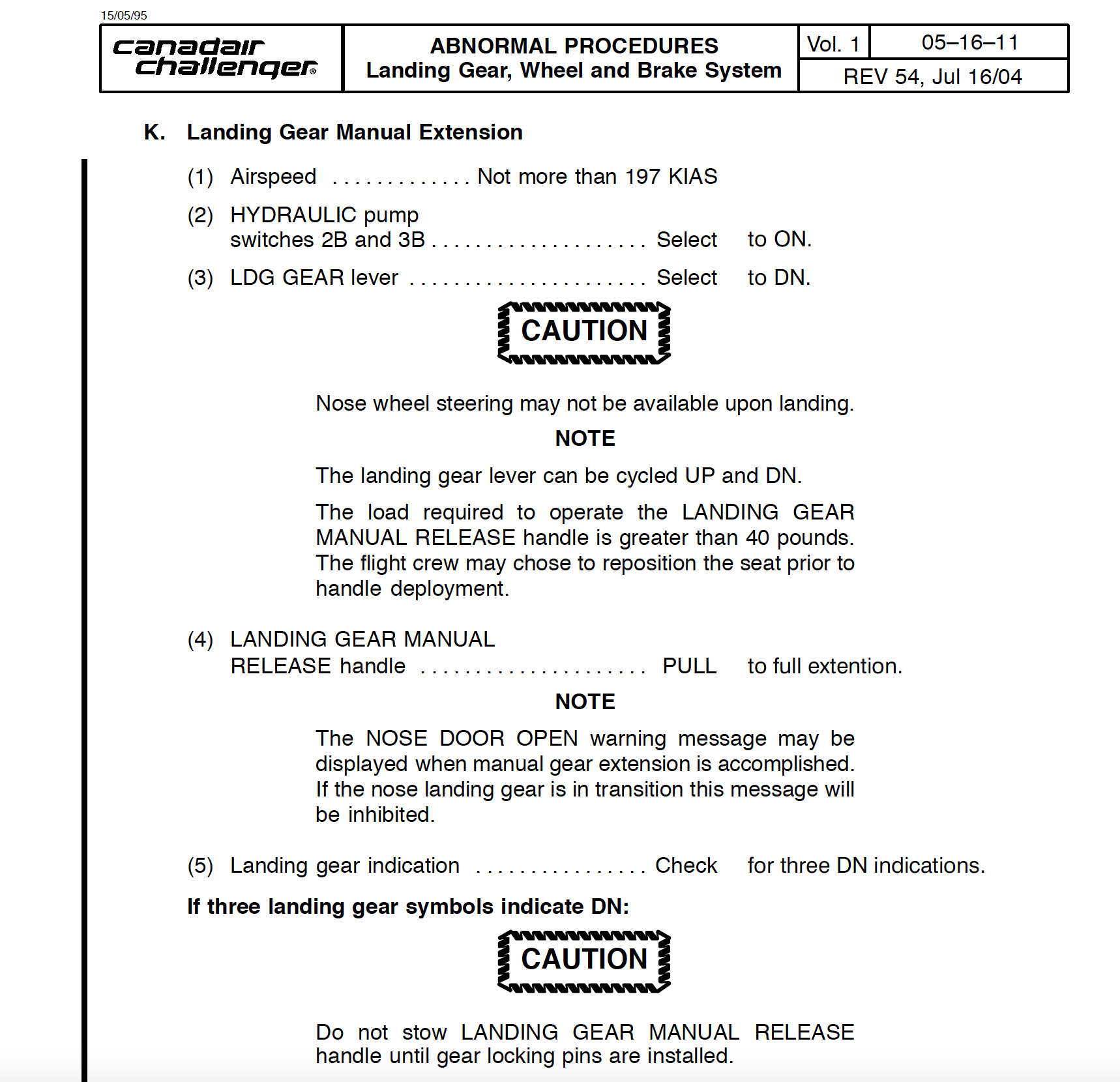
CL-604 Landing Gear Manual Extension checklist, CL-604 OM, Volume 1, page PSP 604-6
I felt the tremble in the flight controls and heard the rumble of the gear falling into place. One by one the gear locked indicators lit. Bob returned to his seat and punched the PA button again. “We managed to get the landing gear down,” he said, “please remain seated for landing.” I looked at Bob and shook my head. "Managed?" I asked. "I got to admit it," Bob said, "I am pretty relieved the gear came down."
For the next few months I wondered about Bob’s reaction to what was a simple in-flight emergency. At my next recurrent simulator training I got the answer. The instructor — let's call him Wayne — brought up the landing gear slides and gave a thorough overview of the system.
“The number three hydraulic system is well protected on this airplane for a reason, gentlemen.” He let his words sink in, and then ominously he continued. “There has never been a successful emergency landing gear extension of a 604 in actual real life conditions.”
“Nonsense!,” I said aloud. The rest of the class just stared at me in disbelief. Wayne was supposed to be the 604 expert. “I just did one a few months back, it worked like a charm.”
“Well,” he said, “you are the first.”
I had a long talk with the training center manager that night. The instructor was taken off the line for retraining. I’ve since heard the same “never been done” story from a few other 604 pilots. It is amazing how much damage an ill-informed instructor can do when unchallenged.
I was a bit surprised by the volume of mail I got on this topic, most of it echoing my findings and imparting a similar story of sophistry in the training environment. Here are some of my favorites.
Dear James,
Thank you for your recent article on sophistry. I write you from a name brand learning facility. Unfortunately many of the issues you discussed in your recent article are on display at this learning center. That combined with the horrific Falcon checklists, has made for a difficult time at this particular training center. I would like your opinion on this matter if I may: The instructors are teaching that we must initiate a bank, "Up to 90 degrees" to accelerate the rate of descent on an emergency descent. For both the Falcon 900 and 2000LX they teach this. I have not yet flown a jet that requires this. The OEM manual does not mention any bank angle at all. I am of the opinion that I would not bank the airplane during a manually flown emergency descent. I've looked through your articles on this and could not find this specific point - I am curious as to your thoughts.
Regards,
Falcon Driver
Dear Falcon Driver,
I smell sophistry! Looking at the DA-900 AFM and CODDE I don’t see any mention of bank angle at all, so they are pushing something the manufacturer doesn’t advocate. So that means it is technique and it is optional. Now, is it good technique?
One way to make that judgment, in a non-subjective way, is to compare the procedures from other manufacturers. The Gulfstream Emergency Descent Mode turns 90° to the left, brings the power levers to idle, and sets the speed to VMO. That turn is made using normal bank angles.
In my opinion, going to a “knife edge” is never wise in a jet. You risk turning one emergency into another. I don’t even do that in an upset recovery. A rapid depressurization is a big deal. But you risk making it an even bigger deal if you end up going negative G in that turn, or exceeding G limits trying to dish it out from that bank. A lot of simulator instructors don’t have any high-G experience in big airplanes and don’t realize how easy it is to “lose it” at high bank angles. Dangerous stuff, this.
James
Dear James,
As always I enjoyed your last article. Like a good book, the ending came up fast.
I have been going through Brand X Sims training since the later 90’s when I began jet training for my first small company job. An old CE500. All my prior training and experience from solo at 17 in 1982 consisted of random instructors, instructing myself, and befriending some guy flying an old C-421 (Best friends still), to gain much desired multi time. I believe that plane taught me more about flying than anything else. No real autopilot, no gps, too big for its temperamental engines and so forth.
Luckily we had the accepted “go to” friend. He had the innate ability to actually know what he was doing. And looking back 25 years, he really did and still does. Currently senior at AA. And still the “go to” guy by his pals. He helped us without knowing it.
I say all this because going to Brand X Sims, I tended to believe my instructors. I had no jet experience. They were instructors after all. I trusted what they told me. What they said was simply the truth. I didn’t stop to think they could be wrong. It didn’t even occur to me. Until after some years of experience and bigger and more expensive type ratings later, did I begin to realize they didn’t have all the answers. Flying for a living taught me that sim school mostly teaches students to pass check rides and type ratings. And the folks teaching lately have very little real world experience but seem to be very open to their students instructing them. It’s a career move for them often. They are more open to admitting “they’re not sure” and if they’re wrong, they admit it. I have noticed this. It’s more of a symbiotic relationship in a way.
Which makes me wonder about the newer less experienced guys going through school. When I first started, the instructors were ex airline/military. Intimating but thorough. Demanding. And easy to accept what they said as gospel. You could fail much easier then. Perhaps they didn’t realize some information they passed on wasn’t accurate, but they did a solid job nonetheless.
It is self study and review about your airplane and the regulations you fly in that is necessary to keep yourself up to date and fresh. I force myself to review the QRH regularly even just for an hour. I think I may be alone in the enjoyment of being challenged in training. I also like to take the check ride first, if possible in the belief that “batting practice” tends to mask what would have happened if it had been an actual flight.
And go from there.
Thank you for your tireless efforts. You’re inspiring pilots to do better.
Best,
An always learning reader
Dear Always Learning,
I must say I got a lot from your email and want to publish it because I think others will too. I've known pilots over the years who cite Brand X Sim instructors as if reading from the flight manual; and now and then they were contradicting the actual flight manual. You are quite right about the change in their instructors over the years and I particularly like your comment about the symbiotic relationship. And that is key to the current day situation. The best instructors are those that realize they are also students. The pilots "out there" bring a wealth of experience. At the same time they need to approach their jobs with the realization that many of their students are taking their words as gospel. That is a heavy responsibility.
James
References
(Source material)
14 CFR 25, Title 14: Aeronautics and Space, Airworthiness Standards: Transport Category Airplanes, Federal Aviation Administration, Department of Transportation
Challenger 604 Operating Manual, Publication No. CH 604 OM, Rev 56, Jan 14/05.
Wolfe, Tom, The Kingdom of Speech, Little, Brown, and Company, New York, 2016.

